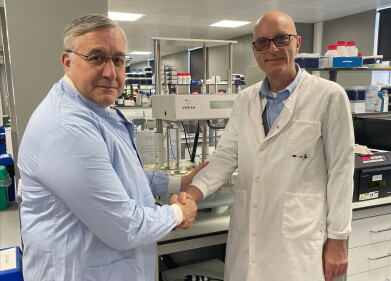News
UK Research Team First to Map Structures of Single Transporter Protein
Jun 23 2010
A team of researchers from the Universities of Leeds, Oxford and Imperial College London have captured the 3D atomic models of a single transporter protein in each of its three main structural states, a goal of
researchers from around the world for over 25 years. The discovery offers remarkable insight into the function of one of the body’s most fundamental processes – the movement of essential chemicals into cells
of the body - and creates the opportunity to develop brand new drugs.
Biologists have surmised that transporter proteins of this type, which sit in the cell membrane, carry molecules through the otherwise impermeable membrane by shifting between at least three distinct structural states, controlled by ion gradients. In the first state, there is an outward-facing cavity. A compound will enter this cavity and attach to a binding site whereupon the protein will move to a second state with the cargo locked inside. The third state is formed when the protein opens up a cavity on the inward-facing side to release the compound into the cell. The switch between outward and inward-facing sides works rather like a ‘kissing gate’ in which the cavity is either on one side or the other but there is never a direct channel through the protein.
However, until now, scientists had never observed the structural details of these three states in a single protein and theories about how the mechanism worked in detail were based on stitching together their observations from different transporters.
“Previous models gave us a broad understanding of the mechanism involved, but this could never really be usefully applied for drug development,” said Professor Peter Henderson of the University of Leeds. “The goal for researchers in this area has always been to observe the entire mechanism in a single protein.”
The research [1] reports the mapping of the inward-facing structure of the bacterial Mhp1 transporter protein, the third structural state that they have determined for this protein. The team has been studying Mhp1 for more than ten years and their observations of the first two structures were published in Science in October 2008.
The protein was produced in Leeds; the structures were determined by X-ray crystallography and analysed at Imperial College and the Imperial College Membrane Protein Laboratory (MPL) located at Diamond Light Source. To further investigate the transitions between the three states of the protein dynamic molecular simulations were carried out at Oxford University.
“This third structure completes the picture and we can now understand Mhp1’s ‘alternating access’ mechanism in great detail,” said Dr Alexander Cameron, from the Division of Molecular Biosciences at Imperial College London. “We also unexpectedly found that the structures are similar across many transporter proteins previously thought to be different, so we’re expecting our model to help achieve some rapid progress in the research of colleagues around the world.”
The detailed knowledge of the mechanism could unlock new drug developments in several ways, said Professor Henderson. “Altering the delivery of compounds into a cell is one potential benefit for treating illness. For example, this could be useful in treating conditions where certain chemicals are lacking and need boosting permanently - such as serotonin for those suffering from depression and glucose for those with diabetes.”
The mechanism’s detail is already being used by chemists in the EUfunded European Drug Initiative on Channels and Transporters consortium (EDICT), which Professor Henderson leads. “We’ve found around 20 compounds that match Mhp1’s binding site, and of these, three have been shown to bind. I think we are entering an exciting period of discovery.”
“It’s taken a long time to get to this point – over ten years – but then difficult science takes time. This is the point at which blue skies research evolves into useful applications,” said Professor Henderson. “It’s the best thing I’ve been involved in during my academic career.”
Funded by the Biotechnology and Biological Sciences Research Council (BBSRC), the EU, the Japanese Science and Technology Agency and the Wellcome Trust, the research team comprises: Professor Henderson and colleagues from Leeds, who expressed and purified the Mhp1 protein; Professor So Iwata, Dr Alex Cameron and colleagues from Imperial College London and the MPL who imaged the crystals and combined all the information to propose a mechanism for the alternating access model; and Professor Mark Sansom and Dr Oliver Beckstein from the University of Oxford who authenticated the plausibility of the transitions between the three states.
Professor Henderson says that the next step is to investigate what triggers the protein to change between the states and the team has secured further funding from BBSRC and the EDICT consortium to pursue this.
[1]. Molecular Basis of Alternating Access Membrane Transport by the Sodium-Hydantoin Transporter Mhp1, Science, 23 April 2010.
Digital Edition
ILM 50.2 March 2025
March 2025
Chromatography Articles - Effects of small deviations in flow rate on GPC/SEC results Mass Spectrometry & Spectroscopy Articles - Waiting for the present to catch up to the future: A bette...
View all digital editions
Events
Mar 17 2025 Milan, Italy
Mar 18 2025 Beijing, China
Mar 20 2025 Brussels, Belgium
Mar 20 2025 Chandigarh, India
ACS National Meeting & Expo, Spring 2025
Mar 23 2025 San Diego, CA, USA



















